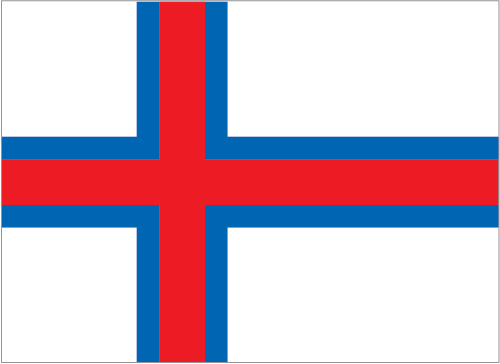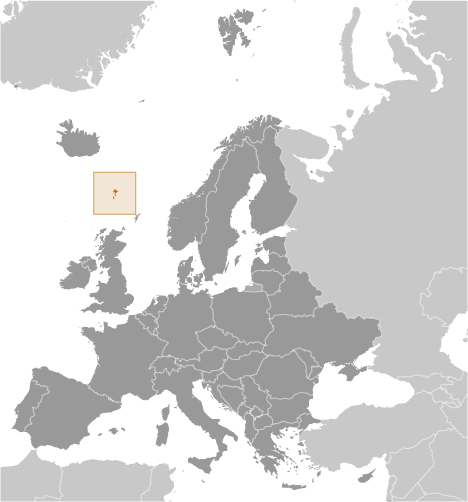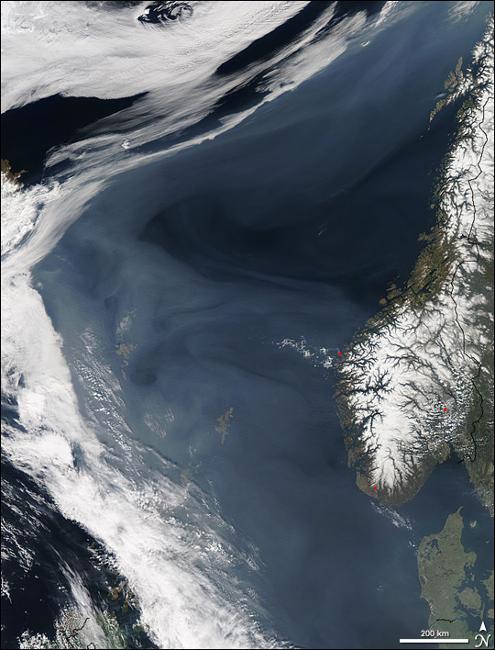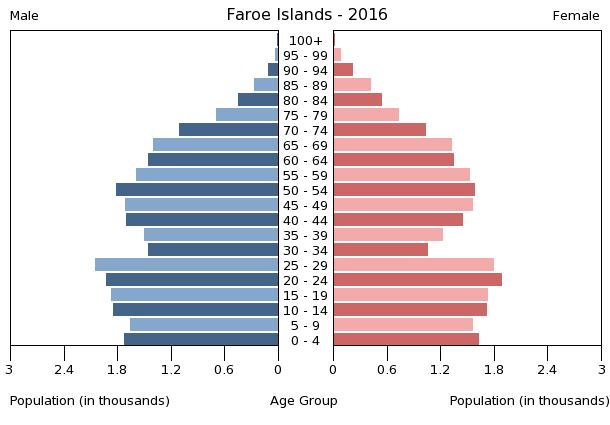Introduction :: FAROE ISLANDS
-
The population of the Faroe Islands is largely descended from Viking settlers who arrived in the 9th century. The islands have been connected politically to Denmark since the 14th century. A high degree of self-government was granted the Faroese in 1948, who have autonomy over most internal affairs while Denmark is responsible for justice, defense, and foreign affairs. The Faroe Islands are not part of the European Union.
Geography :: FAROE ISLANDS
-
Northern Europe, island group between the Norwegian Sea and the North Atlantic Ocean, about halfway between Iceland and Norway
62 00 N, 7 00 W
Europe
total: 1,393 sq km
land: 1,393 sq km
water: 0 sq km (some lakes and streams)
country comparison to the world: 183
eight times the size of Washington, DC
0 km
1,117 km
territorial sea: 3 nm
continental shelf: 200 nm or agreed boundaries or median line
exclusive fishing zone: 200 nm or agreed boundaries or median line
mild winters, cool summers; usually overcast; foggy, windy
rugged, rocky, some low peaks; cliffs along most of coast
mean elevation: NA
elevation extremes: lowest point: Atlantic Ocean 0 m
highest point: Slaettaratindur 882 m
fish, whales, hydropower, possible oil and gas
agricultural land: 2.1%
arable land 2.1%; permanent crops 0%; permanent pasture 0%
forest: 0.1%
other: 97.8% (2011 est.)
the island of Streymoy is by far the most populous with over 40% of the population; it has approximately twice as many inhabitants as Eysturoy, the second most populous island; seven of the inhabited islands have less than 100 people
NA
NA
party to: Marine Dumping - associate member to the London Convention and Ship Pollution
archipelago of 17 inhabited islands and one uninhabited island, and a few uninhabited islets; strategically located along important sea lanes in northeastern Atlantic; precipitous terrain limits habitation to small coastal lowlands
People and Society :: FAROE ISLANDS
-
50,456 (July 2016 est.)
country comparison to the world: 212
noun: Faroese (singular and plural)
adjective: Faroese
Faroese 89.2% (Scandinavian and Anglo-Saxon descent), Danish 7.1%, other 3.7% (includes Icelander, Norwegian, Greenlander, Filipino, Thai, British)
note: data represent respondents by country of birth (2011 est.)
Faroese 93.8% (derived from Old Norse), Danish 3.2%, other 3% (2011 est.)
Christian 89.3% (predominantly Evangelical Lutheran), other 0.7%, more than one religion 0.2%, none 3.8%, unspecified 6% (2011 est.)
0-14 years: 19.98% (male 5,212/female 4,870)
15-24 years: 14.62% (male 3,784/female 3,592)
25-54 years: 37.25% (male 10,191/female 8,605)
55-64 years: 11.66% (male 3,032/female 2,851)
65 years and over: 16.49% (male 4,023/female 4,296) (2016 est.)
population pyramid:

Europe
::FAROE ISLANDS

Population Pyramid
A population pyramid illustrates the age and sex structure of a country's population and may provide insights about political and social stability, as well as economic development. The population is distributed along the horizontal axis, with males shown on the left and females on the right. The male and female populations are broken down into 5-year age groups represented as horizontal bars along the vertical axis, with the youngest age groups at the bottom and the oldest at the top. The shape of the population pyramid gradually evolves over time based on fertility, mortality, and international migration trends.
For additional information, please see the entry for Population pyramid on the Definitions and Notes page under the References tab.
total: 37.7 years
male: 37.1 years
female: 38.4 years (2016 est.)
country comparison to the world: 64
0.53% (2016 est.)
country comparison to the world: 158
14 births/1,000 population (2016 est.)
country comparison to the world: 139
8.7 deaths/1,000 population (2016 est.)
country comparison to the world: 73
0 migrant(s)/1,000 population (2016 est.)
country comparison to the world: 82
the island of Streymoy is by far the most populous with over 40% of the population; it has approximately twice as many inhabitants as Eysturoy, the second most populous island; seven of the inhabited islands have less than 100 people
urban population: 42% of total population (2015)
rate of urbanization: 0.47% annual rate of change (2010-15 est.)
TORSHAVN (capital) 21,000 (2014)
at birth: 1.07 male(s)/female
0-14 years: 1.07 male(s)/female
15-24 years: 1.05 male(s)/female
25-54 years: 1.18 male(s)/female
55-64 years: 1.06 male(s)/female
65 years and over: 0.94 male(s)/female
total population: 1.08 male(s)/female (2016 est.)
total: 5.5 deaths/1,000 live births
male: 5.8 deaths/1,000 live births
female: 5.2 deaths/1,000 live births (2016 est.)
country comparison to the world: 171
total population: 80.4 years
male: 77.8 years
female: 83.1 years (2016 est.)
country comparison to the world: 38
2.36 children born/woman (2016 est.)
country comparison to the world: 83
4.7 beds/1,000 population (2012)
NA
NA
NA
Government :: FAROE ISLANDS
-
conventional long form: none
conventional short form: Faroe Islands
local long form: none
local short form: Foroyar
etymology: the archipelgo's name may derive from the Old Norse word "faer," meaning sheep
part of the Kingdom of Denmark; self-governing overseas administrative division of Denmark since 1948
parliamentary democracy (Faroese Parliament); part of the Kingdom of Denmark
name: Torshavn
geographic coordinates: 62 00 N, 6 46 W
time difference: UTC 0 (5 hours ahead of Washington, DC, during Standard Time)
daylight saving time: +1hr, begins last Sunday in March; ends last Sunday in October
none (part of the Kingdom of Denmark; self-governing overseas administrative division of Denmark); there are no first-order administrative divisions as defined by the US Government, but there are 30 municipalities
none (part of the Kingdom of Denmark; self-governing overseas administrative division of Denmark)
Olaifest (Olavsoka), 29 July
history: 5 June 1953 (Danish Constitution), 23 March 1948 (Home Rule Act), and 24 June 2005 (Takeover Act) serve as the Faroe Islands constitutional position in the Unity of the Realm
amendments: see entry for Denmark (2016)
the laws of Denmark, where applicable, apply
see Denmark
18 years of age; universal
chief of state: Queen MARGRETHE II of Denmark (since 14 January 1972), represented by High Commissioner Dan Michael KNUDSEN, chief administrative officer (since 1 January 2008)
head of government: Prime Minister Aksel V. JOHANNESEN (since 15 September 2015)
cabinet: Landsstyri appointed by the prime minister
elections/appointments: the monarchy is hereditary; high commissioner appointed by the monarch; following legislative elections, the leader of the majority party or majority coalition usually elected prime minister by the Faroese Parliament; election last held on 1 September 2015
election results: Aksel V. JOHANNESEN elected prime minister; Parliament vote - NA
description: unicameral Faroese Parliament or Logting (33 seats; members directly elected in a single nationwide constituency by proportional representation vote; members serve 4-year terms)
note: election of 2 seats to the Danish Parliament was last held on 18 June 2015 (next to be held no later than June 2019); percent of vote by party - NA; seats by party - Social Democratic Party 1, Republic 1
elections: last held on 1 September 2015 (next to be held no later than October 2019)
election results: percent of vote by party - Social Democratic Party 25.1%, Republic 20.7%, People's Party, 18.9%, Union Party 18.7%, Progressive Party 7.0%, Center Party 5.5%, Self-Government Party 4.1%; seats by party - Social Democratic Party 8, Republic 7, People's Party 6, Union Party 6, Center Party 2, Progressive Party 2, Self-Government Party 2
highest court(s): Faroese Court or Raett (Rett - Danish) decides both civil and criminal cases; the Court is part of the Danish legal system
subordinate courts: Court of the First Instance or Tribunal de Premiere Instance; Court of Administrative Law or Tribunal Administratif; Mixed Commercial Court; Land Court - expected to begin in 2016
Center Party (Midflokkurin) [Jenis av RANA]
Independence (or Self-Govenment) Party (Sjalvstyrisflokkurin) [Jogvan SKORHEIM]
People's Party (Folkaflokkurin) [Jorgen NICLASEN]
Progressive Party (Framsokn) [Poul MICHELSEN]
Republic (Tjodveldi) (formerly the Republican Party) [Hogni HOYDAL]
Social Democratic Party (Javnadarflokkurin) [Aksel V. JOHANNESEN]
Union Party (Sambandsflokkurin) [Bardur a STEIG NIELSEN]
other: conservationists
Arctic Council, IMO (associate), NC, NIB, UNESCO (associate), UPU
none (self-governing overseas administrative division of Denmark)
none (self-governing overseas administrative division of Denmark)
white with a red cross outlined in blue extending to the edges of the flag; the vertical part of the cross is shifted toward the hoist side in the style of the Dannebrog (Danish flag); referred to as Merkid, meaning "the banner" or "the mark," the flag resembles those of neighboring Iceland and Norway, and uses the same three colors - but in a different sequence; white represents the clear Faroese sky as well as the foam of the waves; red and blue are traditional Faroese colors
ram; national colors: red, white, blue
name: "Mitt alfagra land" (My Fairest Land)
lyrics/music: Simun av SKAROI/Peter ALBERG
note: adopted 1948; the anthem is also known as "Tu alfagra land mitt" (Thou Fairest Land of Mine); as a self-governing overseas administrative division of Denmark, the Faroe Islands are permitted their own national anthem
Economy :: FAROE ISLANDS
-
The Faroese economy has experienced a period of significant growth since 2011, due to increases in fish prices, salmon farming, and catches in the pelagic fisheries. Nominal GDP growth was an estimated 7.5% in 2013 and 5.9% in 2014. The fisheries sector accounts for about 95% of exports and half of GDP. Unemployment is low, estimated at 2.9% in mid-2015.
The public budget has exhibited deficits since 2008, which were financed through increased borrowing. Public debt reached 38% of GDP in 2015. Aided by an annual subsidy from Denmark amounting to about 4% of Faroese GDP, the Faroese have a standard of living equal to that of Denmark.
Dependence on fishing makes the economy vulnerable to price fluctuations. Projections for fish prices are favorable and increasing public infrastructure investments are likely to lead to continued growth in the short term.
$1.831 billion (2014 est.)
$1.729 billion (2013 est.)
$1.471 billion (2013 est.)
country comparison to the world: 198
$2.32 billion (2010 est.)
5.9% (2014 est.)
7.5% (2013 est.)
2.9% (2013 est.)
country comparison to the world: 26
$36,600 (2014 est.)
country comparison to the world: 51
agriculture: 16%
industry: 29%
services: 55% (2007 est.)
milk, potatoes, vegetables; sheep; salmon, herring, mackerel and other fish
fishing, fish processing, tourism, small ship repair and refurbishment, handicrafts
3.4% (2009 est.)
country comparison to the world: 69
25,000 (2015 est.)
country comparison to the world: 207
agriculture: 10.7%
industry: 18.9%
services: 70.3% (November 2010)
2.9% (2015 est.)
3.1% (2014)
country comparison to the world: 20
NA%
lowest 10%: NA%
highest 10%: NA%
revenues: $1.025 billion
expenditures: $1.301 billion
note: Denmark supplies the Faroe Islands with almost one-third of their public funds (2010 est.)
44.2% of GDP (2010 est.)
country comparison to the world: 22
-11.9% of GDP (2010 est.)
country comparison to the world: 205
calendar year
2.3% (2011)
0.4% (2010)
country comparison to the world: 122
$824 million (2010)
$767 million (2009)
country comparison to the world: 164
fish and fish products 95%, ships (2009 est.)
Russia 20.2%, UK 16.6%, Denmark 16.3%, Nigeria 11.6%, China 9.3%, US 7.2%, Netherlands 5.6%, Norway 4% (2015)
$776 million (2010)
$786 million (2009)
country comparison to the world: 185
goods for household consumption, machinery and transport equipment, fuels, raw materials and semi-manufactures, cars
Denmark 43.9%, Turkey 12.3%, Norway 10%, China 6.2%, Netherlands 4.9%, Germany 4.4% (2015)
$888.8 million (2010)
$68.1 million (2006)
country comparison to the world: 168
Danish kroner (DKK) per US dollar -
6.865 (2016 est.)
6.7236 (2015 est.)
5.6183 (2014 est.)
5.6125 (2013 est.)
5.79 (2012 est.)
Economy :: FAROE ISLANDS
-
The Faroese economy has experienced a period of significant growth since 2011, due to increases in fish prices, salmon farming, and catches in the pelagic fisheries. Nominal GDP growth was an estimated 7.5% in 2013 and 5.9% in 2014. The fisheries sector accounts for about 95% of exports and half of GDP. Unemployment is low, estimated at 2.9% in mid-2015.
The public budget has exhibited deficits since 2008, which were financed through increased borrowing. Public debt reached 38% of GDP in 2015. Aided by an annual subsidy from Denmark amounting to about 4% of Faroese GDP, the Faroese have a standard of living equal to that of Denmark.
Dependence on fishing makes the economy vulnerable to price fluctuations. Projections for fish prices are favorable and increasing public infrastructure investments are likely to lead to continued growth in the short term.
$1.831 billion (2014 est.)
$1.729 billion (2013 est.)
$1.471 billion (2013 est.)
country comparison to the world: 198
$2.32 billion (2010 est.)
5.9% (2014 est.)
7.5% (2013 est.)
2.9% (2013 est.)
country comparison to the world: 26
$36,600 (2014 est.)
country comparison to the world: 51
agriculture: 16%
industry: 29%
services: 55% (2007 est.)
milk, potatoes, vegetables; sheep; salmon, herring, mackerel and other fish
fishing, fish processing, tourism, small ship repair and refurbishment, handicrafts
3.4% (2009 est.)
country comparison to the world: 69
25,000 (2015 est.)
country comparison to the world: 207
agriculture: 10.7%
industry: 18.9%
services: 70.3% (November 2010)
2.9% (2015 est.)
3.1% (2014)
country comparison to the world: 20
NA%
lowest 10%: NA%
highest 10%: NA%
revenues: $1.025 billion
expenditures: $1.301 billion
note: Denmark supplies the Faroe Islands with almost one-third of their public funds (2010 est.)
44.2% of GDP (2010 est.)
country comparison to the world: 22
-11.9% of GDP (2010 est.)
country comparison to the world: 205
calendar year
2.3% (2011)
0.4% (2010)
country comparison to the world: 122
$824 million (2010)
$767 million (2009)
country comparison to the world: 164
fish and fish products 95%, ships (2009 est.)
Russia 20.2%, UK 16.6%, Denmark 16.3%, Nigeria 11.6%, China 9.3%, US 7.2%, Netherlands 5.6%, Norway 4% (2015)
$776 million (2010)
$786 million (2009)
country comparison to the world: 185
goods for household consumption, machinery and transport equipment, fuels, raw materials and semi-manufactures, cars
Denmark 43.9%, Turkey 12.3%, Norway 10%, China 6.2%, Netherlands 4.9%, Germany 4.4% (2015)
$888.8 million (2010)
$68.1 million (2006)
country comparison to the world: 168
Danish kroner (DKK) per US dollar -
6.865 (2016 est.)
6.7236 (2015 est.)
5.6183 (2014 est.)
5.6125 (2013 est.)
5.79 (2012 est.)
Energy :: FAROE ISLANDS
-
300 million kWh (2014 est.)
country comparison to the world: 179
300 million kWh (2014 est.)
country comparison to the world: 184
0 kWh (2013 est.)
country comparison to the world: 176
0 kWh (2013 est.)
country comparison to the world: 183
100,000 kW (2014 est.)
country comparison to the world: 175
60.1% of total installed capacity (2012 est.)
country comparison to the world: 134
0% of total installed capacity (2012 est.)
country comparison to the world: 155
36.1% of total installed capacity (2012 est.)
country comparison to the world: 63
3.8% of total installed capacity (2012 est.)
country comparison to the world: 65
0 bbl/day (2015 est.)
country comparison to the world: 137
0 bbl/day (2013 est.)
country comparison to the world: 179
0 bbl/day (2013 est.)
country comparison to the world: 173
0 bbl (1 January 2016 es)
country comparison to the world: 183
0 bbl/day (2013 est.)
country comparison to the world: 183
4,400 bbl/day (2014 est.)
country comparison to the world: 179
0 bbl/day (2013 est.)
country comparison to the world: 188
4,295 bbl/day (2013 est.)
country comparison to the world: 170
0 cu m (2013 est.)
country comparison to the world: 182
0 cu m (2013 est.)
country comparison to the world: 145
0 cu m (2013 est.)
country comparison to the world: 168
0 cu m (2013 est.)
country comparison to the world: 113
0 cu m (1 January 2014 es)
country comparison to the world: 179
800,000 Mt (2013 est.)
country comparison to the world: 170
Communications :: FAROE ISLANDS
-
total subscriptions: 17,000
subscriptions per 100 inhabitants: 34 (July 2015 est.)
country comparison to the world: 189
total: 63,000
subscriptions per 100 inhabitants: 126 (July 2015 est.)
country comparison to the world: 199
general assessment: good international communications; good domestic facilities
domestic: conversion to digital system completed in 1998; both NMT (analog) and GSM (digital) mobile telephone systems are installed
international: country code - 298; satellite earth stations - 1 Orion; 1 fiber-optic submarine cable to the Shetland Islands, linking the Faroe Islands with Denmark and Iceland; fiber-optic submarine cable connection to Canada-Europe cable (2015)
1 publicly owned TV station; the Faroese telecommunications company distributes local and international channels through its digital terrestrial network; publicly owned radio station supplemented by 3 privately owned stations broadcasting over multiple fr (2015)
.fo
total: 47,000
percent of population: 94.2% (July 2015 est.)
country comparison to the world: 188
Transportation :: FAROE ISLANDS
-
number of registered air carriers: 1 (registered in Denmark)
inventory of registered aircraft operated by air carriers: 3 (registered in Denmark) (2015)
OY-H (2016)
1 (2013)
country comparison to the world: 217
total: 1
1,524 to 2,437 m: 1 (2013)
total: 960 km (2015)
country comparison to the world: 187
total: 37
by type: cargo 20, chemical tanker 7, container 2, passenger/cargo 3, refrigerated cargo 3, roll on/roll off 2
foreign-owned: 28 (Iceland 4, Norway 13, Sweden 11) (2010)
country comparison to the world: 79
major seaport(s): Fuglafjordur, Torshavn, Vagur
Military and Security :: FAROE ISLANDS
-
no regular military forces; the Government of Denmark has responsibility for defense; as such, the Danish military’s Joint Arctic Command is responsible for territorial defense of the Faroe Islands (2016)
defense is the responsibility of Denmark
Transnational Issues :: FAROE ISLANDS
-
because anticipated offshore hydrocarbon resources have not been realized, earlier Faroese proposals for full independence have been deferred; Iceland, the UK, and Ireland dispute Denmark's claim that the Faroe Islands' continental shelf extends beyond 200 nm














